Being a mountainous province in the northwest, about more than 70km from Hanoi, along the highway No.6, Hoa Binh is an ancient land and rich in tourism potential. Here, not only beautiful natural landscapes, spectacular and interesting caves, but villages of ethnic minorities with special cultural features have been an ideal destination of domestic and international tourists.
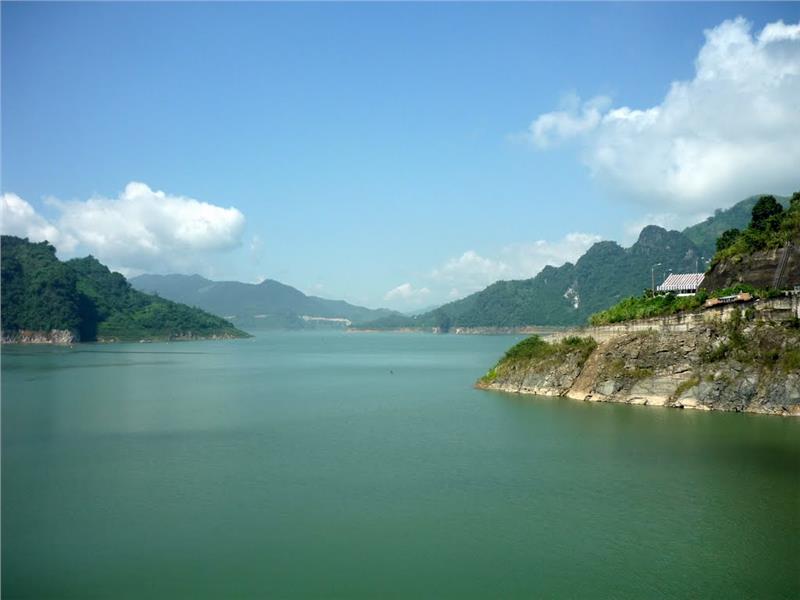
Hoa Binh has the natural area of 4684.2 square kilometers. Hoa Binh is situated between 200 ° 19 '- 210 ° 08’ north latitude and 104 ° 48 '- 105 ° 40' east longitude. It is a mountainous province adjacent to Red River Delta with many roads, waterways connecting provinces of Phu Tho, Ha Tay, Ha Nam, and Ninh Binh; and it is the gateway of the Northwest region. Hoa Binh shares the border with Phu Tho and Ha Tay in the north, Ninh Binh and Thanh Hoa is the south, Ha Tay and Ha Nam in the east and Son La in the west.
The province has high mountainous terrain, complex fragmented, and the steep slopes running the Northwest – Southeastdirection. Hoa Binh topography is divided into 2 areas: the high mountainous area locates in the Northwest with an average altitude of 600 - 700m, craggy terrain, the area of 212.740ha, accounting for 44.8% the whole region; the low mountains situate in the Southeast, an area of 262.202ha, accounting for 55.2% the whole region. The terrain includes low mountain ranges, less fragmented, the average slope from 20 to 250, an average altitude from 100 to 200m.
Hoa Binh has a tropical monsoon climate, cold winter, less rain; hot summer and much rain. The annual average temperature is more than 23 degree Celsius. July is the hottest month; the average temperature is 27-29 degree Celsius, whereas, January is the coldest month with the average temperature of 15.5 – 16.5 degree Celsius.
In addition, the river system in the province is distributed relatively evenly with the large rivers namely Da River, Boi River, Buoi River, Lang River and Bui River.
Hoa Binh province was established on June 22, 1886, under the the decree of Kinh Luoc Bac Ky with the name Muong province, separating the land of Muong people from provinces of Hung Hoa, Son Tay, Ha Noi and Ninh BInh. In April 1888, it was renamed the province of Lam Phuong, ruled by the French ambassador.
March 18, 1891 Governors-General of French Indochina issued a decree to rename Lam Phuong to Hoa Binh. December 27, 1975, Hoa Binh and Ha Tay provinces were consolidated into Ha Son Binh. According to the resolution of the 8th Session of 9th National Assembly 9th in August 12, 1991, Ha Son Binh was split into 2 provinces of Hoa Binh and Ha Tay.
Hoa Binh province has 10 districts and one town including Da Bac, Mai Chau, Tan Lac, Lac Son, Kim Boi, Luong Son, Lac Thuy, Yen Thuy, Ky Son and Hoa Binh town, and 214 communes, wards and towns.
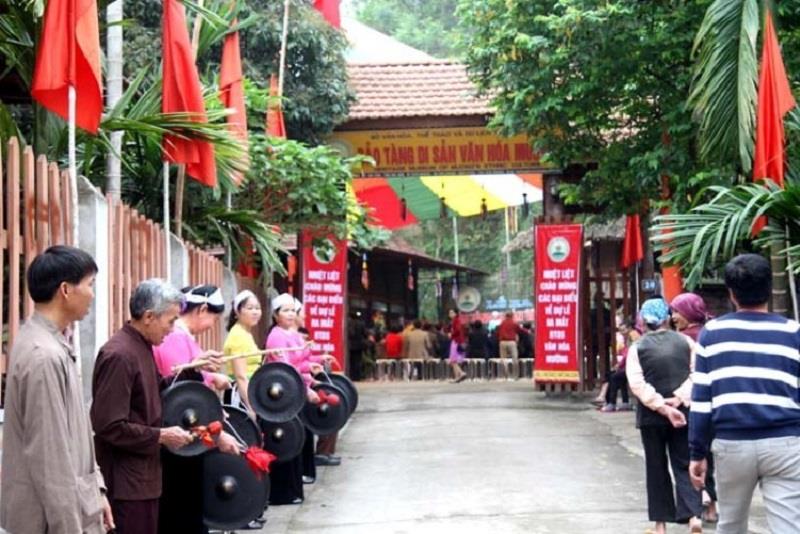
According to the official statistics in 2009, the population of Hoa Binh is 786.964 people.There are 6 ethnic groups living in the province, including 63.3% of Muong people, 27.73% of Kinh people, 3.9% of Thai people, 1.7% of Tay people, 0.52% of Mong people and Chinese people living scattered in districts of the province. In addition, there are people of other ethnic groups getting marriage with Hoa Binh people who work in other mountainous provinces.
Hoa Binh is one of 4 provinces of Vietnam where Kinh people are not the majority, and is considered the capital of Muong people, because most of the Muong people are concentrated here. In term of culture - society, Muong ethnic people is closest to Kinh people. Muong people live in all districts of the province, along with Kinh people and other ethnic groups. Notably, most of ethnic groups in Hoa Binh maintained their own language and have so far used in their daily life. Vietnamese today is the common language in Hoa Binh, which almost people here can understand and communicate.
Quality education is improved; school facilities continue to be strengthened. So far the province has five ethnic boarding schools and 11 ethnic day-boarding schools. The exemption policies of tuition, scholarships for students continue to be implemented and achieved good results. Scientific and technological activities are implemented comprehensively, focusing on scientific research and technology development to serve life and production.Performing synchronously measures for prevention of disease,infrastructure of medical units is upgraded; quality of nurses and doctors is improved.

Due to geographical features adjacent to the Red River Delta and Hanoi, the natural conditions, soil, mineral resources, rich cultural characteristics, Hoa Binh economy has advantage to develop some strengthening indutries.
Production of building materials: with the large reserves of limestone and clay, the current production of building materials is one of the key industries of the province, providing building materials for the region and neighboring provinces. In addition, the province has three cement factories with the capacity of 8.8 thousand tons / year in Luong Son, Yen Thuy and Hoa Binh town.
Agro - forestry products: Hoa Binh owns types of soil suitable for planting many industrial crops (sugarcane, cassava, tea, bamboo...), orchards (orange, tangerine, pineapple, longan...). Therefore, the province can develop agro-processing industry such as sugar, starch, dried tea, canned fruits. Besides, the forest area accounts for 55% in which the area of greened forest is about 41% with many economic swathes allowed growing and exploiting for forest product processing.
Mechanics, electronics, garment and footwear: based on the location adjacent to the major industrial centers of Hanoi and the abundant potential labor in which the rural labor accounts for 84% while the the time uses only 74%, therefore Hoa Binh can develop electronic mechanics industry, garment and footwear Currently, in the province there are some factors such as Song Da Garment Company, May 3/2 Garment Company, Ban Dai factory (producing electrical accessories), and Sankor electric company.
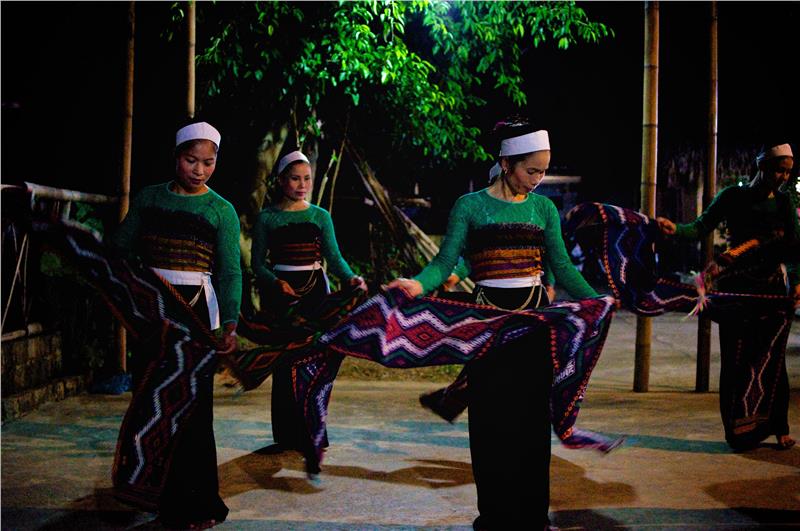
Hoa Binh culture is imbued with the national cultural identity, in which Muong people cover a majority of population up to 60% of population. Muong culture and other ethnic cultures has gathered and created the unique cultures for Hoa Binh. Hoa Binh cultural identity consists of Bronze Drum culture, gong culture, and other cultural genres.
The total bronze drum found in Hoa Binh is 112 units. In ancient times, Bronze Drum was highly valued, it was a tool and a musical instrument used most of the important rituals: such as worship god, pray for good weather, festivals, and funerals. Gongs participate in all daily activities of the community including Sac Bua ceremony, weddings, funerals, huntings, etc.
Muong people in Hoa Binh often live in stilt house called "nha rua" according to the folklore. It has 4 roofs, 3 floors modeled on the folk concept 3 floor 4 worlds of Muong people. In the cuisine, Muong people often eat rice and drink "ruou can". The Muong costume is unique. In particular, the bell dress of Muong people has patterns depicting the pattern on Dong Song Bronze Drum.
Thai people also build stilt houses like Muong people, but the stilt houses of Thai people is larger and arranged tidier. Thai costume is very diverse and unique. Thai ethnic people have many distinct festivals such as fire ceremony, new rice, nem con, xoe dance. Some villages of Thai people in Mai Chau have long attracted tourists by the natural beauty and the richness and uniqueness of Thai lifestyle. In addition, the cultural identities of Thai and H’mong people also contribute to create the beauty in the culture of Hoa Binh.
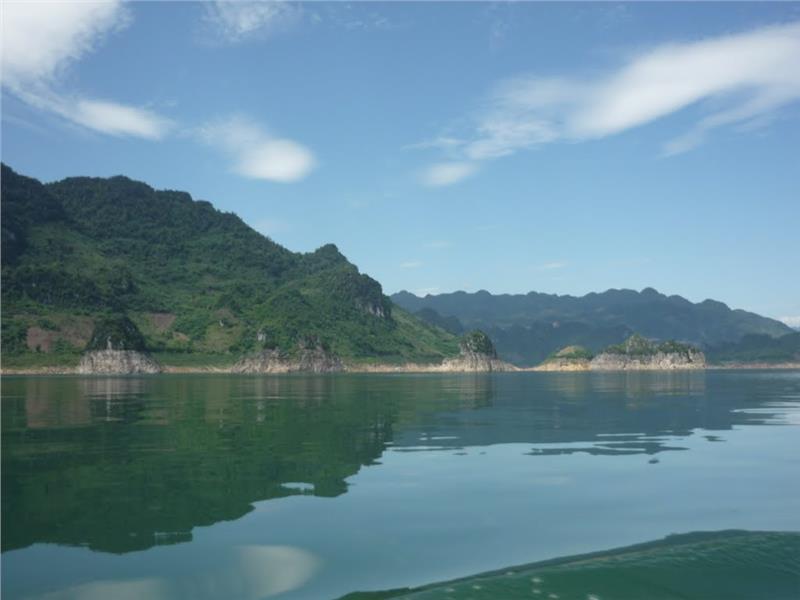
Referring to Hoa Binh, people immediately think about the biggest hydropower project in Vietnam. The massive and eternal work, the vast reservoirs, dam and the floodgate always bring the exceiting feeling for tourists. Standing on the top mountain where the statue of Uncle Ho is place, tourists can contemplate the panoramic view of Hoa Binh and immense hills from a distance and hidden stilt houses in villages of Muong people, Tay people and Thai people.
When visiting Hoa Binh hydropower project, you should remember to visit Kim Boi mineral spring, learn about the legend of (Mr and Mrs Tung) in conquering the Da River to built hydropower. You also drop by Long Vuog temple, Thac Bo cave, Chua Thuong Ngan temple or travel by boat on Hoa Binh Lake.
For long time, Hoa Binh tourism is known for not only hyprpower project, dances, singings, cultural activity communities of ethnic male and female, but Mai Chau valley also appeal numerous tourists. From Hoa Binh town, going 60km, passing through winding roads, tourists will arrive at beautiful Mai Chau valley. Visiting the villages of Thai people in Mai Chau, tourists can contemplate the green trees and rice fields, and immerse in cool nature. Not only do you contemplate high, solid and clean stilt houses, but you also learn about the way of brocade weaving of female here. Staying overnight in stilt houses, tourists can enjoy many delicious dishes and listen to the gong sound and drink "ruou can".
Festival
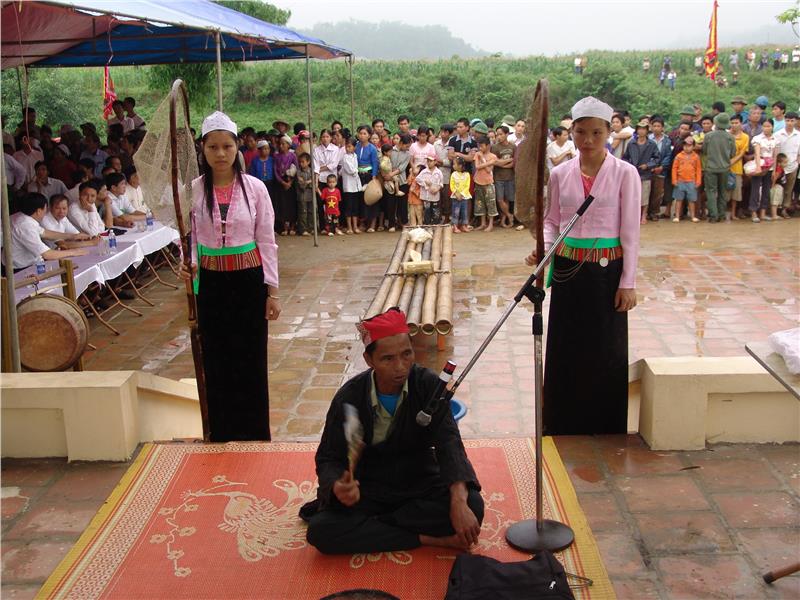
Hoa Binh is a place rich in the cultural identity as well as festivals. Every year, after Tet holiday, tourists coming to Hoa Binh to participate in Den Bo festival to pray for good luck and contemplate the landscape of Hoa Binh hydropower project.Den Bo festival not only commemorates Ba Chua Thac Bo, pray for good luck and prosperity, contemplate the charming landscapes but also learn about the specialties such as: bitter bamboo shoots, lac lay, smoked mouse and grilled fishes.
Gau Tao in Mong language means outdoor play, also known as "dap nui". Gau Tao is a traditional festival of Mong people is organized in the form of rotation. Each year, H'Mong people have a family meeting to select a family in the community responsible for organizing. On behalf of the H'Mong community organizing Gau Tao Festival is a great honor for any family in the village. The preparatory work is made throughout the year. The festival takes place to worship the heaven, gods, pray for health, happiness, prosperity. This is one of the big and famous festivals in Hoa Binh.
Khai Ha Muong Bi festival is the folk festival associated with the wet rice, imbued with the civilization of ancient Vietnamese people. This is the indispensable cultural-religious activities of Muong Bi people, Phong Phu commune (Tan Lac) on the occasion of the early year. The festival shows the dream of the harvests, prosperous life and happiness. Khai Ha festival starts the New Year by 2 parts, namely ceremony and festival. According to the regulation of Muong Bi people, after the ceremony, people can go into the forest to take bamboo shoots, firewood and hunt. So it is so-called "le xuong dong" and "mo cua rung".
